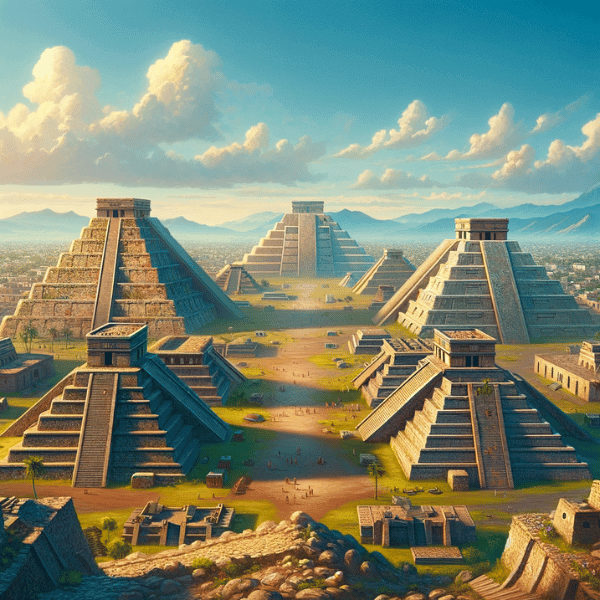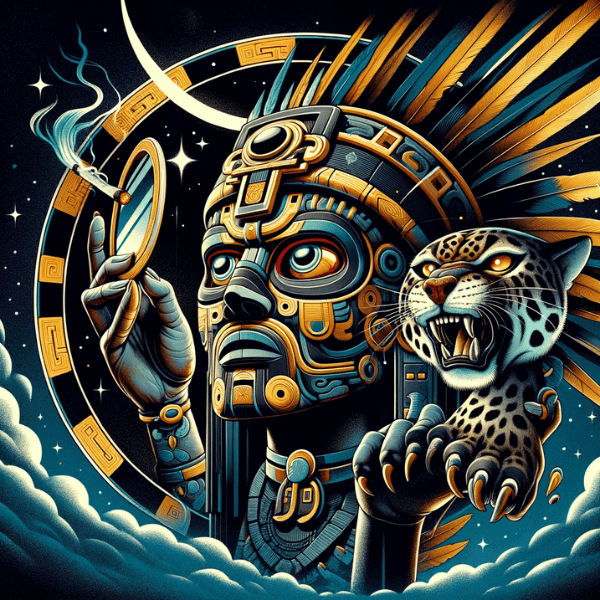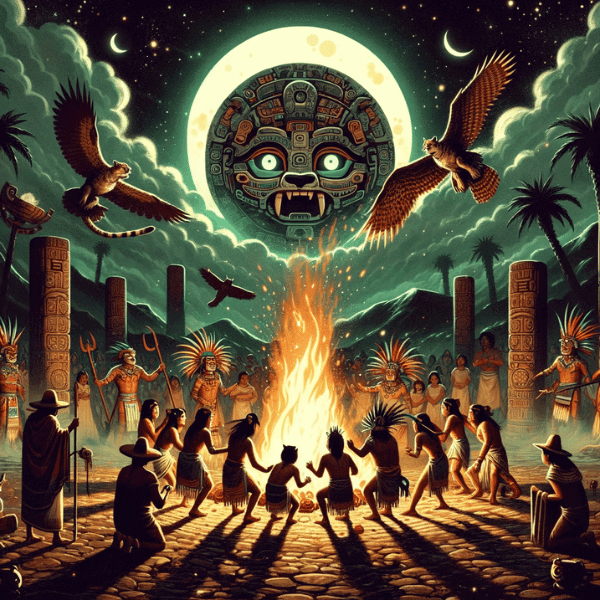In the rich tapestry of Aztec mythology, few deities capture the imagination as vividly as Tezcatlipoca, known as the “Smoking Mirror.” Revered as a god of the night sky, Tezcatlipoca’s enigmatic presence weaves through the fabric of Aztec legends, embodying themes of power, magic, and duality. This article embarks on a journey to unravel the mysteries surrounding Tezcatlipoca, aiming to provide a comprehensive, accurate, and deeply insightful exploration of his role and significance. Through meticulous research and analysis, we delve into the heart of Aztec mythology, uncovering the layers that make Tezcatlipoca a figure of enduring fascination and importance in the study of ancient civilizations and their belief systems.
| Attribute | Tezcatlipoca Information |
|---|---|
| Origin | Aztec Mythology |
| Deity Type | God of Fate, Change, and the Night Sky |
| Appearance | Often depicted with a smoking mirror on his chest and a jaguar motif |
| Role | God associated with destiny, change, and the night sky; a powerful and enigmatic deity |
| Smoking Mirror | Possessed a smoking mirror that could reveal the future and one’s true self |
| Sacrifices | Received human sacrifices, particularly of captured warriors |
| Cultural Impact | A complex and significant figure in Aztec religion, representing the unpredictable nature of life |
| Depictions | Featured in Aztec art and rituals, particularly those related to divination and fate |
1. Historical Context of Tezcatlipoca
The Aztec Civilization
The Aztecs, a Mesoamerican people who flourished in central Mexico from the 14th to the 16th century, created one of the most sophisticated and powerful civilizations of the pre-Columbian Americas. The Aztecs marked their society with complex social structures, innovative agricultural practices, and remarkable architectural achievements, notably in their capital, Tenochtitlán. They intricately wove their advanced understanding of mathematics, astronomy, and ecology into their daily lives and belief systems, making them a civilization ahead of their time.
Mythology: The Soul of Aztec Culture
Mythology in Aztec culture was not mere folklore; it was the cornerstone of their societal and religious practices. Gods and mythical figures were deeply integrated into Aztec life, influencing everything from political decisions to agricultural practices. Myths served as a bridge between the natural and supernatural worlds, providing explanations for natural phenomena and guiding moral and ethical codes. Tezcatlipoca, as a central deity, was integral in this mythological framework, embodying the Aztecs’ complex worldviews.

Unearthing Tezcatlipoca
Our understanding of Tezcatlipoca primarily comes from three sources: archaeological findings, ancient codices, and historical records from the post-conquest period. Archaeological excavations, particularly in and around the ruins of Tenochtitlán, have unearthed relics and artifacts that depict Tezcatlipoca and provide insights into his worship. Ancient codices, such as the Codex Borgia and the Codex Borbonicus, offer rich pictorial representations and narratives about Tezcatlipoca. Post-conquest historical records, written by Spanish conquistadors and indigenous scribes, offer additional perspectives, though often colored by the biases and viewpoints of their authors. These diverse sources together paint a multi-faceted picture of Tezcatlipoca, allowing us to piece together his significance in the Aztec pantheon.
2. The Mythology of Tezcatlipoca
Tezcatlipoca: The God of Many Faces
Tezcatlipoca, whose name translates to “Smoking Mirror,” is a figure shrouded in mystery and complexity. He is often depicted as a young, vigorous deity bearing a black and yellow striped face, with a smoking mirror replacing one of his feet. This mirror, a symbol of his ability to see everything, reflects his role as a god of omniscience and prophecy. Tezcatlipoca’s attributes also include the jaguar, a representation of his earthly power and warrior spirit, and the night sky, signifying his dominion over the celestial and the mysterious.

Legends of Power and Intrigue
The stories surrounding Tezcatlipoca are as diverse as his representations. One of the most famous legends describes his rivalry with the feathered serpent god, Quetzalcoatl. This rivalry culminates in Tezcatlipoca using cunning and magic to exile Quetzalcoatl from the Aztec city of Tollan, showcasing his trickster nature. Another significant legend involves his role in the creation of the world, where he is said to have sacrificed himself to become the sun, only to be dethroned by his brother Quetzalcoatl.
A Central Figure in the Aztec Pantheon
In the Aztec pantheon, people revere Tezcatlipoca as one of the most powerful gods, often regarding him as a creator deity and a rival to Quetzalcoatl and Huitzilopochtli, another primary god of war and the sun. His relationships with other deities are complex and multifaceted, often embodying themes of conflict, balance, and duality. Tezcatlipoca’s influence extends to various aspects of life, including war, politics, and magic, making him a central figure in Aztec religious and cultural practices. His worship was marked by elaborate ceremonies and rituals, including human sacrifices, reflecting his significance and the Aztecs’ deep reverence for him.
3. Cultural Significance of Tezcatlipoca
Influencing Aztec Society and Rituals
Tezcatlipoca’s influence on Aztec society was profound and pervasive. As a god of royalty and the nobility, he played a crucial role in the political realm, often invoked in royal ceremonies and decision-making processes. In the religious sphere, people worshiped him through various rituals and ceremonies, with the most notable being the Toxcatl festival. During this annual event, they treated a young man chosen to embody Tezcatlipoca with great reverence for a year before ultimately sacrificing him. This ritual underscores the Aztec belief in the cyclical nature of life and death, a concept central to their understanding of the divine.

Symbolism of Night, Jaguars, and the Unseen
Tezcatlipoca’s symbolism in Aztec culture extends to the night, jaguars, and the unseen realms. As the god of the night sky, he was associated with the mysteries and powers of darkness, a counterbalance to the sun’s life-giving force. The jaguar, a fierce and powerful predator of the Americas, was a fitting representation of Tezcatlipoca’s warrior aspect and his dominion over the earthly realm. Furthermore, his association with the unseen reflects the Aztecs’ belief in a universe filled with hidden forces and untold mysteries, with Tezcatlipoca as a guiding and omnipresent deity.
Comparative Mythological Analysis
Tezcatlipoca’s attributes and significance find echoes in various other mythologies. Comparable deities include Odin from Norse mythology, who shares Tezcatlipoca’s association with magic and wisdom, and the Greek god Hermes, known for his cunning and trickster qualities. In Hindu mythology, Lord Shiva shares similar attributes of destruction and regeneration, embodying the dual nature of creation and annihilation. This comparative analysis highlights the universality of certain themes in world mythologies, such as power, duality, and the balance between the seen and unseen worlds.
4. Tezcatlipoca in Modern Context
Contemporary Cultural and Media Resonance
In today’s world, Tezcatlipoca’s influence extends beyond historical and academic circles, permeating contemporary culture and media. This Aztec deity has inspired various forms of artistic expression, ranging from visual arts to music, symbolizing themes of power, mystery, and transformation. Modern media often portrays characters embodying duality, cunning, and a profound connection to the natural and supernatural realms, drawing from Tezcatlipoca’s mythology.

Modern Literary, Artistic, and Cinematic Interpretations
Tezcatlipoca’s enigmatic persona has captivated modern writers, artists, and filmmakers, leading to intriguing interpretations in literature, art, and film. In literature, writers often depict him as a complex character who embodies both benevolence and malevolence, reflecting the multifaceted nature of his mythological counterpart. In visual arts, contemporary artists have reimagined Tezcatlipoca, often focusing on his symbolic attributes like the smoking mirror and jaguar. Films, too, have drawn inspiration from his legends, using his character as a metaphor for themes like destiny and the human psyche.
Tezcatlipoca in Current Religious Practices
Among indigenous communities in Mexico, Tezcatlipoca’s legacy continues to hold a significant place in religious practices and cultural identity. Rituals and ceremonies paying homage to Tezcatlipoca are still observed, albeit in forms adapted to contemporary contexts. These practices not only honor the deity but also serve as a means of preserving and revitalizing indigenous cultural heritage. The enduring veneration of Tezcatlipoca highlights the deep-rooted and ongoing connection between ancient Aztec beliefs and modern indigenous spirituality.
5. Conclusion
Tezcatlipoca, the Aztec “Smoking Mirror,” emerges from the annals of history as a deity of unparalleled complexity and intrigue. His multifaceted nature, embodying power, duality, and transformation, has left an indelible mark on Aztec mythology and continues to influence modern culture and religious practices. From the depths of historical analysis to the realms of contemporary art and media, Tezcatlipoca’s legacy persists, offering rich insights into the human condition and the timeless themes of the unseen, the mysterious, and the powerful. His enduring relevance in both ancient and modern contexts underscores the profound impact and lasting importance of mythological figures in shaping our understanding of the world and our place within it.
